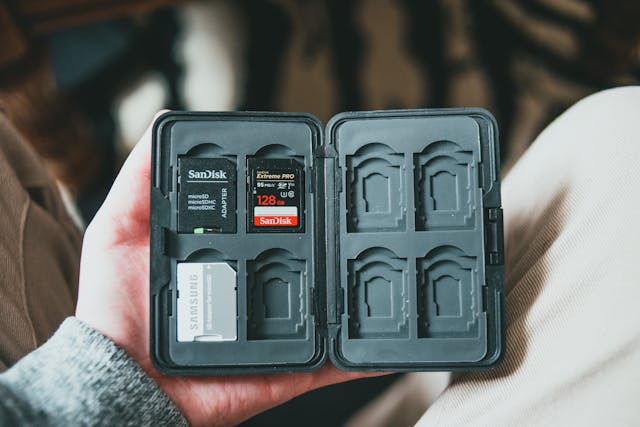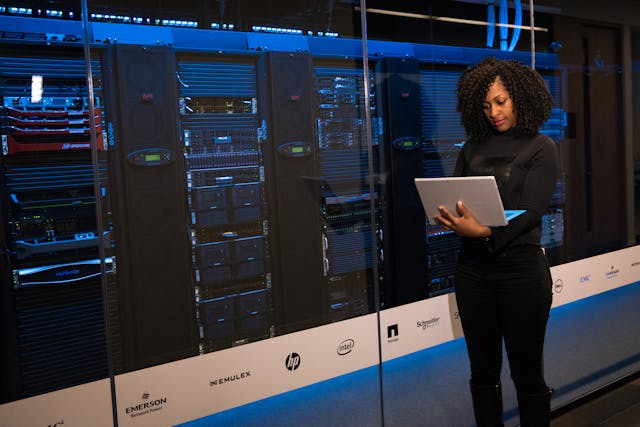The Development of Data Storage: From Memory Cards to the Cloud
Data storage is evolving rapidly. Gone are the days of relying solely on physical devices for safeguarding photos, documents, and business information. Cloud storage has revolutionized data management, offering unmatched benefits. Join us as we explore the shift from memory cards to the cloud and its many advantages.
Written by human for humans
We already talked about the history and evolution of memory cards, electronic data storage devices used for storing digital information. From the introduction of PC cards in 1990 to the advanced SDUC cards with up to 128 TB capacity, they proved to be a compact, widely used electronic storage medium that can store data for long periods of time without a need for a power supply. Their history is long and fascinating, their development going in parallel with the increasing complexity of mobile phones, digital cameras and other widely-used electronic devices.
But since 2018, when SDUC cards were announced, the digital environment changed. Storage needs have grown, driven by high-resolution photos, videos, and drone usage. And while memory cards evolved significantly, there are situations where cloud storage is cheaper, more environmentally friendly and more practical.
Cloud storage has emerged as a natural progression from memory cards, offering a scalable solution for users facing the growing data demands, ensuring their data is easily accessible and securely backed up. In the following, we will compare both solutions.
Memory cards – loyal companions or electronic waste
Choosing the right size memory card to accommodate ever-growing data needs can be a challenge. Imagine you're going on a year-long journey, constantly capturing memories through photos and videos. You start with one SD card, but as the year progresses, you find yourself continually needing to purchase new ones.

This leads to an increasing collection of cards to manage. Each new card presents the task of ensuring it has adequate capacity to store all your media without running out of space at a critical moment.
Finding the right memory card is more than just picking one with enough storage space. Compatibility issues can cause frustration and inconvenience. For instance, you might buy a high-capacity SD card for your camera, only to discover it doesn't work with your new smartphone. Different devices have varying specifications and requirements, and not all cards are universally compatible. Ensuring that your chosen card works seamlessly across all your devices requires careful consideration of the specifications.

Transferring photos from your memory cards to your computer might seem like a safe way to store your data, but this introduces another risk: theft. If your computer is stolen, all your memories are lost unless you have backups stored elsewhere. This adds another layer of complexity and concern to your data management strategy.
Physical limitations of memory cards further complicate their use. Memory cards are small, fragile and susceptible to physical damage. Dropping your camera with an SD card inserted can lead to data corruption or complete loss, rendering your memories inaccessible. The delicate nature of memory cards means they need to be handled with care, and any physical impact can have consequences for your data.
Managing data storage with memory cards involves navigating challenges related to capacity, compatibility, and physical durability. Whether it's the ongoing need for more storage space, ensuring device compatibility, safeguarding against theft, or protecting against physical damage, each aspect requires consideration to prevent future data loss and to maintain the integrity of your memories.
There is another, environmental perspective. The production of memory cards has a significant impact on the environment through plastic usage and the generation of tons of electronic waste. Memory cards are made from various materials – plastics, metals, and semiconductor materials, all of which require energy and resources to produce. Their encasing is made of plastic and the extraction and processing of petroleum for plastic production has substantial environmental consequences, including habitat destruction, water pollution, and greenhouse gas emissions.
Once manufactured, the plastic components contribute to the growing problem of plastic waste, which is notoriously difficult to manage and can persist in the environment for hundreds of years. As technology advances, older memory cards are often discarded, which adds to the electronic waste problem. Electronic waste contains hazardous materials like heavy metals and chemicals that can leach into the soil and water, posing risks to human health and the environment.

While recycling offers a potential solution to mitigate the environmental impact of discarded memory cards, the reality is less promising. Recycling programs for small electronics are often limited and inconvenient. Many consumers are unaware of where or how to recycle these items, and the small size of memory cards makes them easy to overlook when recycling electronic waste. Even when they are recycled, the process is challenging. Memory cards must be dismantled to separate the various materials from which they are made, which is labor-intensive and not always economically viable. As a result, a significant portion of memory cards ends up in landfills despite the potential for recycling.
Cloud storage – a sustainable alternative to memory cards
Cloud storage is a solution offering its users the option to store data on remote servers accessed via the internet, rather than on local storage devices like hard drives or memory cards. When you upload your data to the cloud, it is securely stored on servers managed by your cloud storage provider, who manages the infrastructure required to store and protect your data.

Cloud storage providers offer vast storage capacity, often far exceeding what can be achieved with physical storage devices. This way you never have to worry about running out of space for your important files. There is usually a variety of storage plans to choose from, which suit different user needs, ranging from gigabytes to terabytes of storage space.
Cloud storage presents a more sustainable alternative to memory cards since it does not require physical materials, therefore eliminating the plastic usage and electronic waste. Data stored in the cloud is kept in large data centers, which, while energy-intensive, are continually innovating to reduce their environmental footprint. They are adopting renewable energy sources, such as solar and wind power while advancements in energy-efficient technologies and cooling systems are helping them to decrease the overall impact on the environment.
Aside from being a greener solution, one of the key benefits of cloud storage is accessibility. You can access your files from anywhere with an internet connection, using any device such as your phone, tablet, or computer. This eliminates the need to carry around physical devices, making it more convenient to access your data on the go.
Cloud storage is scalable, allowing you to easily upgrade your storage. As your data needs grow, you can seamlessly increase your cloud storage plan without needing to buy new hardware. Cloud storage providers typically offer robust security measures to keep your data safe. This includes data encryption to protect your files from unauthorized access, as well as backup options to ensure your data is always accessible even in the event of a hardware failure. Cloud storage security exceeds what can be achieved with memory cards, providing peace of mind for its users.
Cloud storage is a solution for those who appreciate collaboration. It allows you to easily share files and folders with others. You can share your holiday photos with family and friends instantly, or collaborate on work documents with colleagues in real-time. Sharing files and folders using memory cards is cumbersome and inefficient, requiring physical transfer of the storage device.
Cloud storage is an environmentally friendly, practical solution that offers peace of mind with is security features. Check out Koofr cloud storage today and try out our features. From generous storage plans, security and accessibility to great collaboration options. Enjoy the convenience of being able to access your files from anywhere, anytime.
Cloud storage vs. memory cards - different data management approaches for different situations
While cloud storage offers many benefits, there are still scenarios where memory cards are needed. Professional photographers often need immediate offline storage for large shoots, especially when working in remote locations without reliable internet access. Memory cards provide a portable and reliable solution for storing large volumes of high-resolution photos until they can be transferred to a more permanent storage. Drone operators also frequently require on-location storage for the captured footage, particularly in situations where transferring data to the cloud is not feasible due to limited connectivity or time constraints. Memory cards allow drone operators to quickly store footage on-site and continue capturing without interruption.

A hybrid approach, combining both cloud storage and memory cards, is able to offer the best of both worlds. The user uses memory cards for initial capture and backup of data in the field, ensuring immediate offline storage and redundancy. Then they transfer data from memory cards to the cloud storage for long-term storage and accessibility. This allows seamless access to files from anywhere with an internet connection and provides an additional layer of protection against data loss.
In conclusion, memory cards have limited storage capacity, which means frequent replacement and storage management. We also need to prevent possible compatibility issues when using them with different devices. They are susceptible to physical damage, which can cause data loss or corruption and thus presents a big risk to data safety. However, memory cards remain valuable in specific scenarios where immediate offline or on-location storage is required.
Cloud storage on the other hand offers numerous advantages to its users. It provides convenience by allowing easy access to files from anywhere with an internet connection, eliminating the need to carry physical storage devices. Upgrading your storage plan as your data needs grow is simple, no need to purchase additional hardware or manage multiple memory cards. Security measures such as encryption and backup options protect your data from loss and theft, making cloud storage a secure option. Cloud storage is a more convenient, secure, and scalable solution for managing digital files, making it the preferred choice for most users.
As the world becomes increasingly digital, cloud storage is poised to become the dominant method for data storage. With ongoing advancements in technology and infrastructure, cloud storage will continue to evolve, offering even more robust security features and innovative capabilities in the future. Try out Koofr cloud storage and enjoy the benefits of seamless file access, scalability, and peace of mind knowing your data is safe and secure.
Do you use memory cards, cloud storage or both? Share your experience and opinion on Koofr subbredit!


